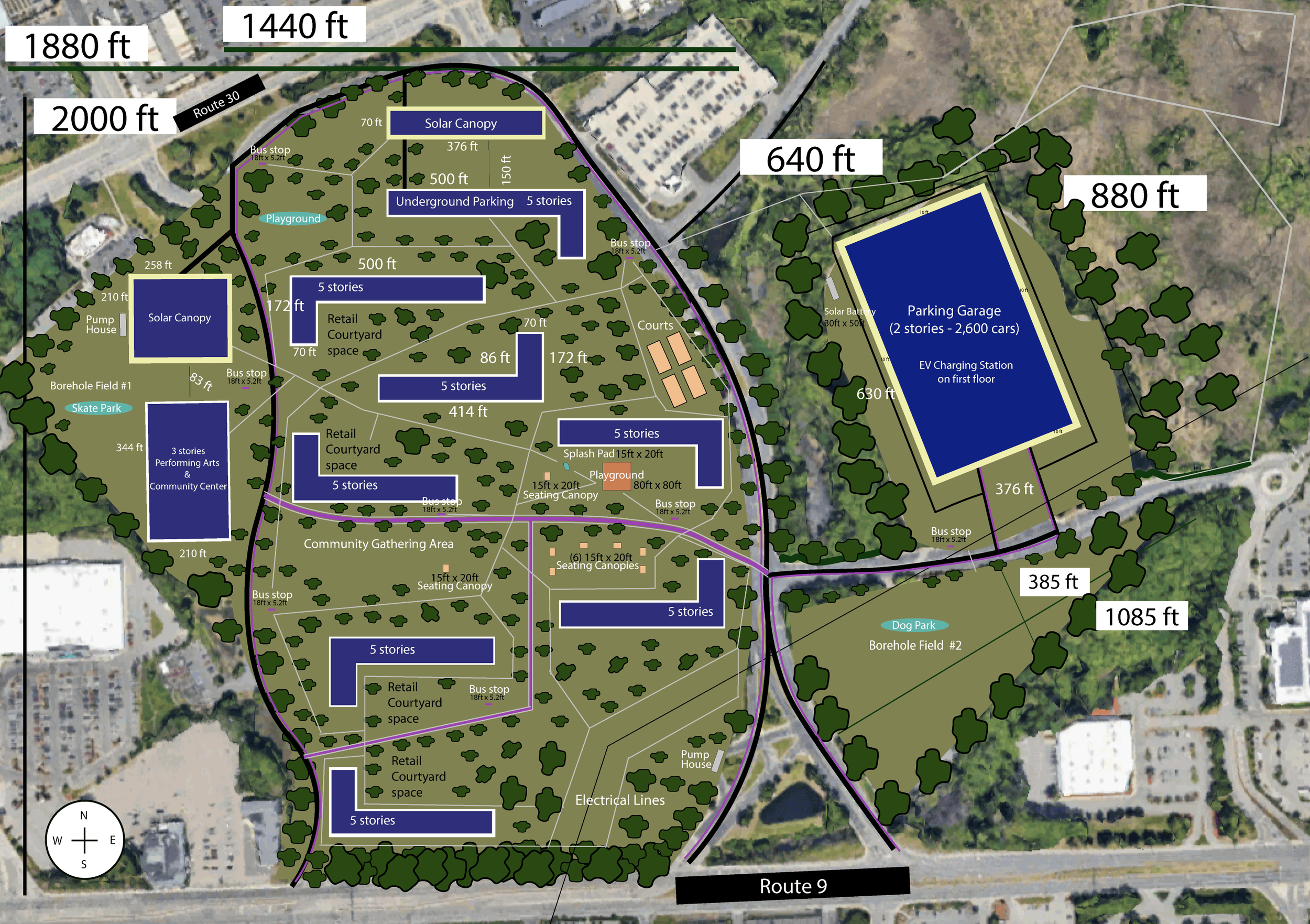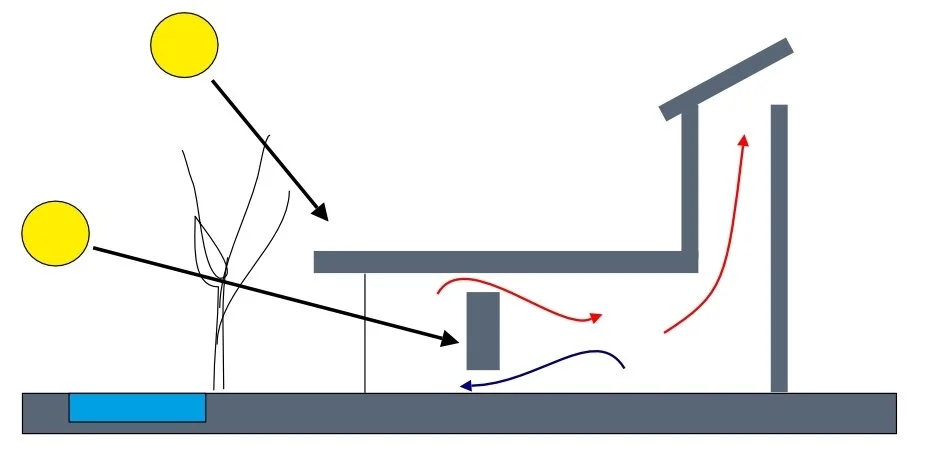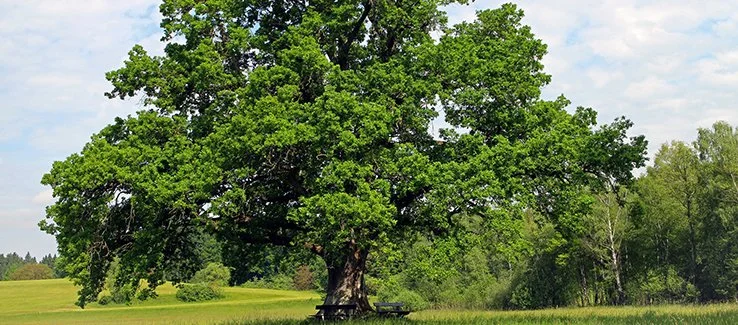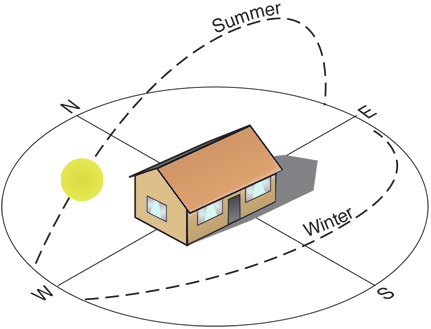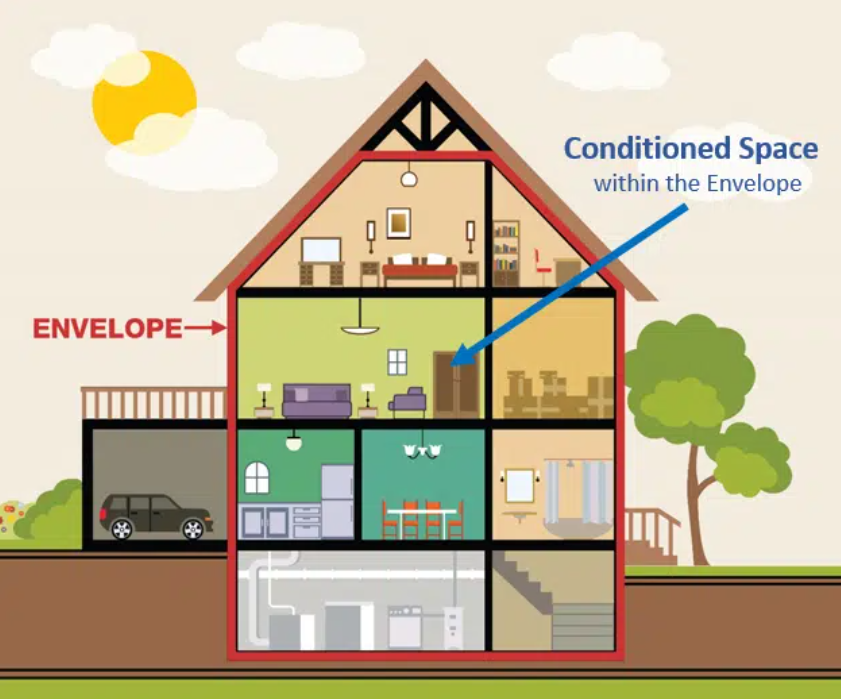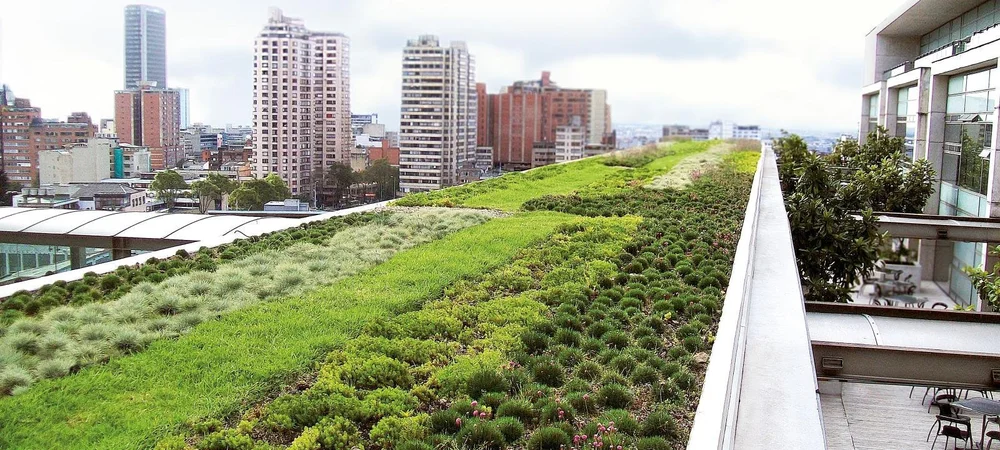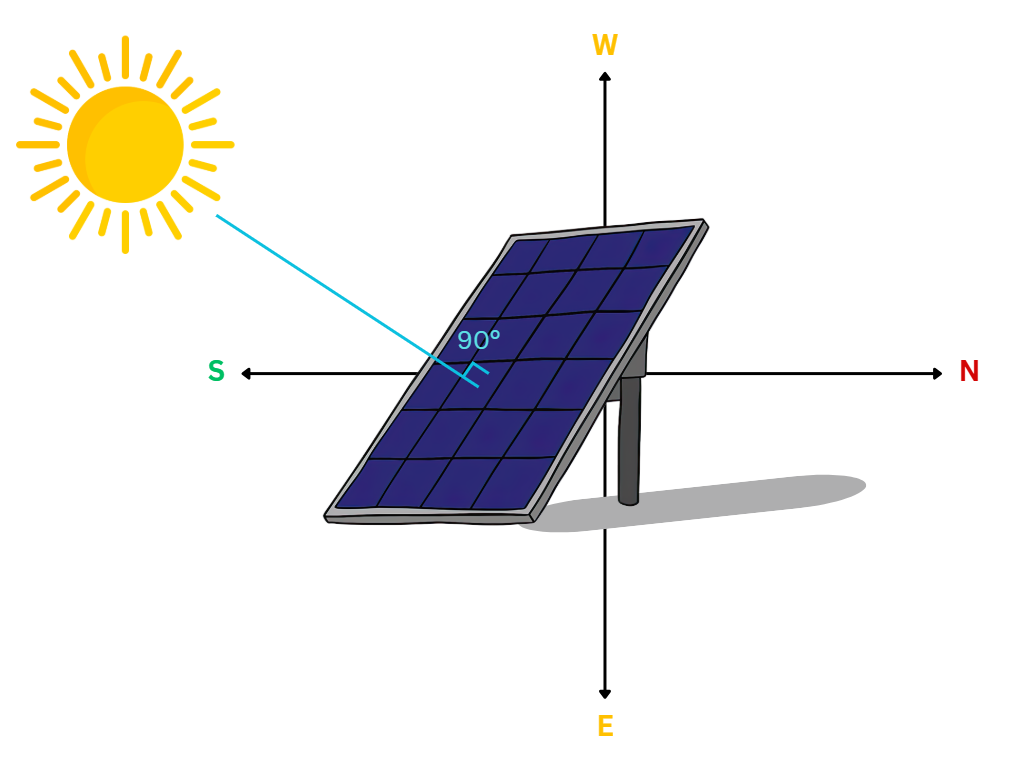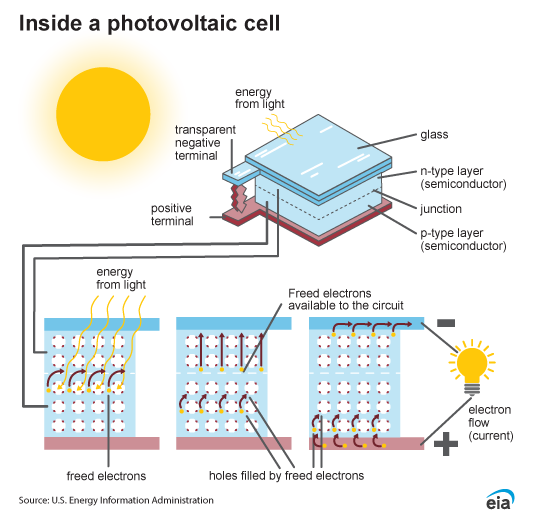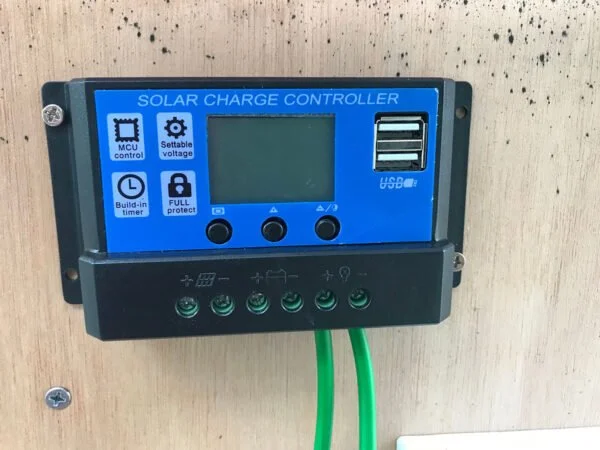SUMMER 2025 INTERNSHIP PROGRAM
PERSPECTIVES OF EARTH TEAM MENTORSHIP & INTERNSHIP
2025 PROJECT - VISION
The McAuliffe Center, through the PETM Summer Internship, envisions the redesign of what is known as “Shoppers World” in Framingham, MA. This is a timely project since the new owners of Shoppers World, Urban Edge, have already proposed to the City of Framingham to transform a portion of the shopping mall into a mixed-use development.
Through this project, the McAuliffe Center aims to contribute the voice and perspectives of young members of the MetroWest community to the Shoppers World redevelopment. We believe that we can contribute to a thoughtful sustainable design after which other redevelopments of commercial lots in MetroWest may be modeled.
Vision Document
GOAL FOR SUMMER 2025
PETM was charged to develop a proof of concept for a 100% clean energy self-sufficient 15-min urban community that will replace the existing Shoppers World. The study focused on the integration of three key climate solutions: geothermal networks, photovoltaic systems, and passive building design.
Passive Building Design | Networked Geothermal System | Photovoltaic System
Proposed Design for Energy Assessment Study
Legend
Passive Building Design Glossary
Net Zero: A net zero building is a building that generates as much energy on-site as it uses. The area aims to completely negate the amount of greenhouse gases produced by human activity, achieved by reducing emissions and implementing methods of absorbing carbon dioxide from the atmosphere.
Passive Design: Passive design is a type of building design and site orientation that prioritizes reducing energy use. It minimizes a building’s reliance on mechanical systems, such as heating, cooling, and lighting, while focusing on utilizing natural elements like sunlight, wind, and vegetation.
Solar Exposure: Solar exposure is the amount of solar radiation that is directed at a certain place.
Vegetation: Trees and shrubs create different air flow patterns, provide shading and keep the surroundings cooler in warm weather. Vegetation can be used for energy conservation in buildings by shading buildings, the use of roof gardens, acting as buffers against cold and hot winds, and changing the direction of wind. The green cover lowers ambient temperatures through evapotranspiration.
Evapotranspiration: Evapotranspiration (ET) is the process where water moves from the Earth's surface to the atmosphere. Plants absorb water through their roots and release it as vapor through their leaves (transpiration), while also, water evaporates from soil and other surfaces (evaporation). Both of these processes require heat, which is absorbed from the surrounding air, thus lowering the air temperature. Evapotranspiration can alter the micro-climate of a site.
Deciduous Trees: Deciduous trees are trees that seasonally shed their leaves, typically in the autumn, and then regrow in the spring. Examples are oaks and maple which provide shade in summer and allow solar gain in winter.
Coniferous Trees: Coniferous trees, also known as conifers, are cone-bearing seed plants, typically evergreen trees or shrubs with needle-like or scale-like leaves.
Thermal Insulation: Thermal insulation is the process of reducing heat transfer between objects or spaces by using materials that resist the flow of heat.
Orientation: Orientation is the relative position of a building to the sun. Building orientation has significant impacts on the building’s energy efficiency, by harnessing the sun for solar gain for heating.
Ventilation: Ventilation is how the wind flows through a house. Ventilation also brings fresh, clean air into a house.
Wind Rose: A wind rose shows how many hours per year the wind blows from the indicated direction. This wind rose for Framingham, MA shows the wind comes from the west.
Urban Heat Island: Urban heat islands are urbanized areas that experience higher temperatures than outlying areas. Structures such as buildings, roads, and other infrastructure absorb and re-emit the sun’s heat more than natural landscapes such as forests and water bodies.
Thermal Envelope: The thermal envelope of a building is the physical barrier that separates the conditioned (heated or cooled) interior from the unconditioned exterior or other unconditioned spaces, like an attic or garage.
Thermal Bridging: Thermal bridging occurs when the walls are more conductive than the insulation. Thermal bridging is a main cause of heat lost in poorly insulated homes. It happens around doors and windows as well as studs.
Energy Efficiency: Energy efficiency is the term used for reducing the amount of energy used.
Green Roofs: A green roof is a roofing system where the roof surface is partially or completely covered with vegetation and a growing medium (plants, soil, rocks), installed over a traditional roof.
Electric Charging Station: An electric charging station is used to charge an electric vehicle. Charging stations produce much less greenhouse gases than a regular car. For 100% clean energy, the charging stations used will be powered by solar energy.
Electric Bus: Electric buses use a battery to power the bus, not fossil fuels, making it clean transportation.
Flat Roof: A flat roof is one where there is no slant or gable on top of a building.
Shed Roof: A shed roof is a roof where there is only one slant. Shed roofs are good for solar panels as the roof can be angled though it also has to be angled to the south.
Passive Building Design System Components
System of a Passive Neighborhood: The system of a neighborhood is composed of multiple smaller systems. The neighborhood system has houses, apartments, vegetation, sidewalks, and roads, retail space, and community spaces.
- Houses
- Vegetation
- Sidewalks
- Roads
- Solar panels
Houses: Houses are important for the system of a neighborhood because they house the people who live there. Inside the houses they use passive design.
Vegetation: Trees and shrubs create different air flow patterns, provide shading and keep the surroundings cooler in warm weather. Vegetation can be used for energy conservation in buildings by shading buildings, the use of roof gardens, acting as buffers against cold and hot winds, and changing the direction of wind. The green cover lowers ambient temperatures through evapotranspiration.
Sidewalks/Pathways: Sidewalks are important to increase the walkability while having enough green space as well as an aesthetic view.
Roads: Roads are important in a passive neighborhood because they provide accessible transportation to and from homes, retail, and entertainment.
Photovoltaic (Solar Panels): The sunrays (photons) coming from the sun goes/absorbs into the solar panels. The photovoltaic cell is where energy is converted to electricity. Inside the photovoltaic cell, the photon’s energy “excites” the electrons from the material (silicon) of the photovoltaic cell. This is our primary source of electricity.
System of a Passive House: The system is composed of natural ventilation, natural heating and illumination from the sun, and vegetation.
- Insulation
- Glazed Windows
- Ventilation
- Energy Recovery Ventilator (ERV)
- Seasonal Shading
- Courtyard
Timberboard: TimberBoard wood fiber insulation is a rigid, sustainable wall, floor, roofing, and continuous exterior insulation solution that stands strong against the harshest elements.
Aerated Concrete: Autoclaved aerated concrete (AAC) is concrete that has been manufactured to contain closed air pockets. AAC is one-fifth the weight of concrete. AAC has medium thermal mass and provides very good thermal insulation.
Glazed Windows: Glazed windows, especially triple glazed windows, are important as they keep the heat from the summer out and heating in the winter in. This is good for passive design as it lowers the cost of heating and cooling as air cannot escape.
Ventilation: Ventilation is important because it brings cool air into a hot home and therefore cools it down. This is important for passive design because it lowers the cost of cooling and consequently uses less energy.
Seasonal Shading: Seasonal shading is important for passive design because in the winter the sun is lower so the shade doesn’t cover the window completely and therefore allows more heat from the sun in. In the summer it is opposite as the shading blocks the window more and stops the heat from entering and heating a cool home.
Courtyard: The courtyard look is inspired from looking at different countries and seeing how they set up their buildings. The look was inspired from an aesthetic and privacy point of view. It also allows for more greenspace, and increases the walkability.
Energy Recovery Ventilator (ERV): An Energy Recovery Ventilator (ERV) is the air exchanger that connects to your heating and cooling system to pull fresh, clean air into your home and remove unclean, cycled air. An ERV system uses two fans: one fan to pull fresh air into the building and another fan to push the stale air out. A heat exchanger works to transfer heat and moisture from one air stream to the other, preventing any loss of heat from this ventilation method. Also, an ERV system captures contaminants, allergens, and other pollutants as the outside air enters the home.
Networked Geothermal Glossary
Geothermal Network: Networked geothermal refers to a system where multiple buildings are connected via a network of underground pipes to share geothermal energy for heating and cooling. This interconnected approach allows buildings to exchange heat, utilizing the earth's consistent temperature as a thermal reservoir, leading to greater efficiency and potential cost savings compared to individual ground source heat pumps. The term “networked geothermal” describes both the technology—geothermal—and the mode of delivery—a network. For our purposes, geothermal means delivering heat (“thermal”) from the ground (“geo”) to heat a building using a heat pump. This type of heat pump is called a ground-source heat pump.
Ground Source Heat Pump (GSHP): A heat pump system that uses the ground as a heat source and/or heat sink. In a closed loop system, the heat exchanger is typically coils of high-density polyethylene pipe installed in the ground under or around a building. A heat transfer fluid, usually water or water mixed with antifreeze (propylene glycol, ethanol or methanol), is circulated through this pipe, warming or cooling to the temperature of the earth or rock around it.
Borehole: A borehole is a shaft drilled into the ground to access resources or explore the subsurface. In the context of geothermal boreholes are dug several hundred feet where the soil temperature remains relatively stable throughout the year, regardless of seasonal air temperature fluctuations.
Borefield: A system of boreholes interconnected with each other in order to increase the efficiency of the heat exchange and retention of the heat contained within the ground loop.
Ground loop: It is a U-shaped PEX pipe that is buried vertically in a borehole where the soil temperature remains relatively stable throughout the year. This consistency is what the geothermal system needs in order to have a thermal exchange with the temperature of the water contained inside the loop and the temperature with the ground outside it.
Thermal Conductivity: Thermal conductivity measures how well a material conducts heat. High thermal conductivity materials, like copper and aluminum, are efficient at heat transfer. Low thermal conductivity materials, such as wood or styrofoam, are good insulators meaning there is low heat transfer. A ground loop requires materiasl which are high in thermal conductivity in order to facilitate the heat transfer from the water inside the loop into the ground surrounding it.
Grout: Grout is a heat-conductive mixture of water, sand, and bentonite clay that fills the space between the U-shaped pipe and the surrounding borehole. It helps improve heat transfer between the pipe and the earth while also securing the pipe in place.
Refrigerant: A refrigerant is a fluid used in geothermal heat pumps to transfer heat. It absorbs heat from the ground loop and releases it indoors to warm the air. In cooling mode, it works in reverse, removing heat from indoor air and sending it back into the ground.
BTU: BTU or British Thermal Unit is a measure of heat content of fuels or energy sources.
Tonnage (tons): It is a measure of thermal energy carried within a space. 1 Ton is equivalent to 12,000 BTU’s.
Heat waste: Heat waste refers to excess thermal energy that is released into the environment instead of being reused. In geothermal systems, this heat can be recovered. An example of heat waste is a refrigerator as they generate heat as a byproduct of their cooling process, and this heat is typically expelled into the surrounding environment. In a geothermal system heat waste can be recovered in order to provide heat into a different space or for a different utility.
Bedrock: Bedrock is the hard area of rock in the ground that holds up the loose soil above.
Building Envelope: The physical separator between the conditioned and unconditioned environment of a building, including the resistance to air, water, heat, light, and noise transfer. Often regarded as how tightly sealed the building is to the outside environment.
Coefficient of Performance: COP is a measurement of how efficiently a heat pump operates. It is calculated by dividing the heating or cooling output by the energy input. A higher COP means greater energy efficiency.
Distributed Pumping System: A system made up of smaller, individual pumping stations (one flow center for each heat pump) each controlled individually by the operation of the specific heat pump unit that they serve.
Heat Pump: A mechanical device used for heating and cooling which operates by moving heat energy from one location to another (generally for comfort conditioning). Heat pumps can draw from or discharge heat to air, water, or earth, and are most often either air source or water source.
Radial Drilling: Radial drilling is often installed beneath existing constructions, due to the small nature of the equipment used and minimal surface disruption. Radial drilling involves creating multiple angled boreholes from a single central chamber, forming a radial pattern that maximizes subsurface heat exchange.
Central Access Chamber: The primary vertical borehole is drilled to serve as the main access point.
Radial Boreholes: From this central chamber, multiple smaller boreholes are drilled outward at various angles, covering a 360-degree circumference. Radial drilling allows for dense, efficient geothermal fields with minimal surface disruption.
Expansion Valve: A device that reduces the pressure of liquid refrigerant entering the evaporator and meters and regulates the flow of refrigerant so that it can properly absorb heat.
Compressor: The compressor increases the pressure of a refrigerant fluid, and simultaneously reduces its volume, while causing the fluid to move through the system. Added pressure increases the heat of the refrigerant.
Boiler: A device that heats water using conventional combustion fuel sources.
Desuperheater: A device for recovering heat from the compressor discharge gas of a heat pump or central air conditioner for use in heating or preheating water. Also known as a heat recovery water heater.
Pump House / Pump Station: A pump house is a centralized building that contains the circulation pumps and control systems for a geothermal network. It moves fluid through the underground loop and into each connected building, ensuring consistent heating and cooling throughout the system.
Networked Geothermal System Components
A Geothermal System: A closed loop geothermal system, where there are multiple buildings linked to the system by their respective heat exchangers.
- Geothermal Network
- Pump House / Pump Station
- Vertical Loop System
- Heat Pump
Pump House / Pump Station: A small building or enclosed structure that houses critical pumping and control equipment for the system. The pump house is the main component that moves the water in the closed loop through the different buildings in the system.
Vertical Loop System: A vertical loop system is the portion of a geothermal ground loop where fluid circulates through deep boreholes. These boreholes contain U-shaped pipes that absorb or release heat depending on the season, using the earth’s stable underground temperature.
Heat pump: In each building or space a heat pump takes in the water from the geothermal ground network and uses the thermal energy from the water in order to transfer it into the air which travels through the duct work facilitating the heat transfer from ground to air.
Circulating Pump: The pump house contains the main circulating pump that pushes the liquids across the different buildings and bore in the network.
Loop System: The ground pipes which perform the heat exchange for a heat pump.
Horizontal Loop: A horizontal closed loop field is composed of pipes that are arrayed in a plane in the ground. A long trench, deeper than the frost line(deeper than 6ft), is dug and U-shaped geothermal tubing is placed in it.
Vertical Loop: A vertical system consists of a number of boreholes some 50 to 1500 feet deep fitted with U-shaped pipes through which a heat-carrying fluid that absorbs (or discharges) heat from (or to) the ground is circulated.
Closed-Loop: System of geothermal water/antifreeze pipes which only has to be filled once. The same water is just pumped up and through the system, delivering heating or cooling to the buildings and boreholes,where the fluid is not exposed to the atmosphere.
Slinky Loop: A horizontal loop where piping is coiled like a slinky to fit more length into a smaller area.
Ductwork: A system of air ducts that distributes heated or cooled air from the geothermal heat pump throughout the building’s rooms.
Photovoltaic Glossary
Alternating current (AC): Type of electrical current that reverses directions between voltages over time. AC is the preferred type of current for the electricity grid because it can be easily converted to higher or lower voltages as needed.
Angle of incidence: The angle between an incoming ray (of light) and a line perpendicular to the surface at which the ray strikes. Optimal solar panel production occurs when the angle of incidence is 90 degrees.
Battery Energy Storage System: Solar battery banks attach to a PV system and can store excess electricity produced by the system, instead of the excess electricity being lost or exported back to the grid. Battery energy storage systems can extend the flexibility and longevity of PV systems by adjusting to peaks and dips in energy demand throughout the year.
Conversion Efficiency: The efficiency of a PV array refers to the amount of sunlight absorbed by the array compared to the amount of electricity produced by the array. Most solar panels today have a conversion efficiency rate of around 18-22%.
Direct Current (DC): An electrical current that flows consistently in one direction. Not preferred for electricity grids because it is difficult to convert to higher or lower voltages.
Electrical Grid: The electric grid is a system connecting power stations, substations, and transmission wiring to deliver electricity to consumers.
Electricity load: The amount of electricity consumed by a device or system. In buildings, load refers to the amount of electricity required to run a building.
Energy: The ability or capacity to do work or cause change over a specific period of time.
Grid-tied systems: PV systems that are connected to the utility electricity grid, usually by utility meters. Also called grid-connected systems.
Inter-row spacing: The distance between rows of solar panels, usually mandated by building codes, fire safety regulations, and maintenance needs.
Kilowatt Hour (kWh): The flow of electrons per an hour. The way energy consumption and production is measured.
Nameplate: The maximum output an array can produce, in theoretical ideal conditions. Can also be called system capacity, peak capacity, ideal capacity.
Net metering: An solar panel incentive program where you can export excess electricity generated by your PV system back into the electricity grid for a credit on your next utility bill.
Net Zero: Sustainable development goal of reducing carbon emissions to zero. Globally, the Net Zero goal means all emissions released to the atmosphere by human activities are counterbalanced by removing carbon by the atmosphere.
Optimization: Solar panel optimization refers to the manipulation of solar technology parameters to maximize the electricity production of the system. Factors affecting optimization: tilt, direction of panel, local latitude, local temperature, size of system, system loss components, seasonal variations in sun angle.
Orientation: Two elements of solar panel orientation: direction and angle of tilt. Most efficient direction: south-facing Most efficient tilt: depends on local latitude, seasonal sun angle, surface the panels are on.
Photon: A basic unit (quantum) of electromagnetic radiation. Photons represents the entirety of the electromagnetic spectrum and are the basic representation of light particles.
Photovoltaic (PV): The process of converting sunlight into electricity.
PV System: Multiple PV arrays chained together and connected to the an inverter (and often the electrical grid) create a PV system.
Semiconductor: A material that only conducts electricity when energy is provided; for solar panels, the energy is sunlight. The most commonly used semiconductor material in PV construction is silicon.
Soiling: A build up of debris such as soil or dust that cover solar panels and decrease their efficiency. Soiling and panel shading account for the majority of efficiency loss.
Solar Power: A form of renewable energy created by solar technologies that convert sunlight into electricity.
Solar Surface area: The amount of surface area covered by solar panels. The physical dimensions of the size of an array. Maximizing the solar surface area is key for optimizing the efficiency and production of the system.
Solar Wire: A specialized electrical wire that can sustain fluctuating outside conditions and high voltages to carry the current from the solar cell to the inverter.
System Capacity: The maximum output an electricity generator can produce.
System Loss: Factors that can reduce a PV system’s overall conversion efficiency. Factors include soiling, shading, change to irradiance, and temperature.
Tilt: The angle of the solar panels, calculated to reach the ideal angle for maximum insolation absorption and conversion. Dependent on local latitude, seasonal sun angle, calculations to reach angle of incidence.
Urban Heat Island: Where urban areas experience higher temperatures than their surrounding rural areas often created by mankind.
Photovoltaic System Components
Photovoltaic System:
Photovoltaic Cell: The photovoltaic cell is where energy is converted to electricity. The sunrays (photons) coming from the sun is absorbed by the PV cell. Inside the photovoltaic cell, the photon’s energy “excites” the electrons from the material (silicon) of the photovoltaic cell. This causes the bonds of the photovoltaic cell to break and then the electrons start bouncing around everywhere really fast. This excitement creates a directed current DC/flow of electricity because the “hole” (absence of the electron) is positively charged and the electron is negatively charged.
A single PV device, which can be chained together with many cells to create a PV panel. It can usually produce 1-2 Watts of electricity
PV panel / PV module: Multiple PV cells chained together make up a PV panel or module
Strings: A series of solar panels connected in a line, forming one electrical circuit.
Photovoltaic Array: Multiple PV panels chained together make up a PV array.
Controller: The controller is the regulator between solar panels and the solar battery. It controls the power being delivered to the battery so that the battery doesn’t overcharge or get damaged.
Battery Bank: The part of solar systems used to store excess energy. Often in the events in which energy is NOT put back into the grid. This is crucial for a net zero community as during winter months where energy production may be at a low, a battery will still allow the use of previously produced clean energy.
Inverter: An electronic device, usually shaped like a box, that converts direct current (produced by the PV system) into alternating current (used by the electricity grid). Key component of the PV system because it allows the electricity created by the PV system to be used by the electrical grid. It can be a single inverter for the whole system or multiple microinverters, one attached to each module.
Meter: A meter is a tool used by utility companies that track the consumption of energy by a building or electrically powered equipment for billing purposes by a utility company.It tracks the flow of energy in watts which is then converted to kWh. They take the kilowatts used in one billing period then divide that by the billing period to get an averaged per day consumption and tax the consumer with a set rate of kWh/day used.
Back to the Grid or Directly to Appliances: The electricity that is produced is then sent to the appliances and elements of the building that require energy. Any excess electricity can be sent to the grid for a credit on your utility bill or can be sent to a battery for storage and later use.
Support structure (racking): This is how the array is supported and attached to whatever structure it is built on. These structures are also called racking and can vary depending on the size and placement of the solar installation. Installation on flat roofs requires different racking than installation on slanted roofs, which requires different racking than installation on the ground or solar canopies.
Setbacks: Distance between the panel and the edge of the roof or the distance between the panel and other objects on the roof. Typically a mandated distance, determined by building codes for fire safety and maintenance purposes.
Solar canopy/carport: An elevated structure integrated with solar panels that provides shade and shelter for parked vehicles.
Funders for this project include: Community Foundation for MetroWest, Mabel Louise Riley Foundation, Massachusetts Clean Energy Center, Massachusetts Executive Office of Education, Framingham State University and Massachusetts Space Grant Consortium.
Subject Matter Experts, who provided advice to the project, from: Linnean Solutions, Solect Energy, HEET, Geothermal Drillers Association, Urban Edge and City of Framingham, Sustainability Committee / Capital Projects and Facilities Management.
For more information, please contact Dr. Irene Porro, Director, McAuliffe Center for Integrated Science Learning at iporro@framingham.edu
ABOUT THE CHRISTA McAULIFFE CENTER
The Christa McAuliffe Center at Framingham State University was established in 1994 to honor Christa McAuliffe, the first teacher in space and Framingham State’s most famous alumna. The Center has been offering space science education programs to K-12 audiences since its inception. Over the past ten years, however, the Center acquired the technical capacity and content expertise to enable a much wider range of immersive learning experiences establishing the Christa McAuliffe Center for Integrated Science Learning as a modern hub for integrated and project-based learning.
Today, our programming features immersive experiences in space science and beyond, including a focus on environmental and sustainability activities, and programs at the intersection of science, social science and the arts. Our programs, designed in partnership with educators, scientists, artists, and media specialists, promote diversity and inclusion in STEM fields and serve K-12 audiences and undergraduate students, K-16 educators, community-based organizations and a growing community of lifelong learners. The McAuliffe Center also serves as an effective regional catalyst for collaboration among Framingham State University, regional businesses and industries, workforce and economic development initiatives, K-16 institutions statewide, and nonprofits organizations.
ABOUT PERSPECTIVES OF EARTH TEAM MENTORSHIP & INTERNSHIP (PETM)
Established in 2019, PETM promotes youth engagement in STEM disciplines by leveraging youth’s concerns for local environmental problems, while also fostering community participation in environmental mitigation and adaptation initiatives. This strategy fosters students’ environmental literacy and professional skills, and promotes youth’s lasting motivation for participation in STEM education and workforce pathways. Every school year, PETM recruits diverse cohorts of students from high schools in the MetroWest region of Massachusetts to participate in a spring preparatory program. This leads to the selection of a dozen of students who will be part of the summer internship program.
This year, PETM interns were introduced to a wide range of climate-critical workforce pathways, practiced foundational competencies and developed interpersonal confidence. Professionals from a range of green economy industries participated in the PETM internship activities. Specific expertise was drawn from employers in the project areas directly related to the summer project and promoted by the Massachusetts Clean Energy Center’s Massachusetts Climate Careers: Powering the Future:
Buildings of the Future - Explore how to design Passive-Design buildings for a greener future
Harnessing the Power of the Sun for our Communities - Explore and promote solar projects in Massachusetts.
Going Deep! Networked Geothermal Projects - Explore the science and design of networked geothermal systems and how it can contribute to clean heating and cooling.
OUR 2025 HIGH SCHOOL INTERNS
Sami Ettahiri, Ollie deHollan, João Carlos Monteiro, Sameera Patnala, Jon Majkut
Brynlee Barrette, Sanvi Venkayala, Risha Patel, Nayva Mittal, Nhien Nguyen, Noah Menendez
Concept Map and Web Design by Justine Greenwood

